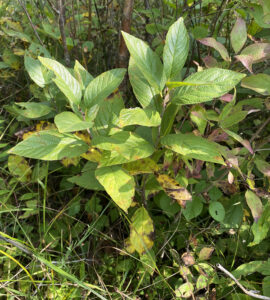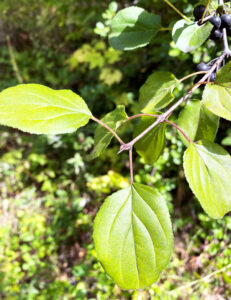
The native alder-leaved buckthorn is much smaller than its invasive counterparts and prefers wet areas such as fens. / Photo Credit: Wisconsin DNR
By Mary Bartkowiak, DNR Invasive Plant Program Coordinator, Rhinelander Service Center;
Mary.Bartkowiak@wisconsin.gov or 715-493-0920
and Erika Segerson-Mueller, DNR Invasive Plant Program Specialist, Oshkosh Service Center;
Erika.Segersonmueller@wisconsin.gov or 715-492-0391
Most of the rather frequent buzz about buckthorn revolves around the two non-native, invasive types: common and glossy. The Wisconsin Department of Natural Resources (DNR) reminds the public that while these aggressive plants and serial invaders are common in Wisconsin forests, there is also a benign and native buckthorn that gets much less attention.
Many people are surprised to learn about this small shrub that has eluded notoriety, unlike its close relatives. Native buckthorn, also known as alder-leaved buckthorn (Rhamnus alnifolia), is a demure shrub that doesn’t grow much taller than 3 feet and prefers wet areas with calcium in the soil.
The presence of native buckthorn is a great indicator of a fen (a low and marshy or frequently flooded area of land fed by a steady source of ground water). Fens have alkaline soil that is high in nutrients, thus plant diversity is often higher in these areas than in bogs, which are typically enclosed depressions filled by rainwater.
Native buckthorn has a leaf shape similar to that of common buckthorn (Rhamnus cathartica), with small teeth on the leaf margin. The tips of leaves on the native buckthorn are acute (tapering to a point with more-or-less straight sides) and there are large lateral veins that curve along the margin of the leaves. These leaves are arranged alternately along the stem and the berries each contain three seeds. The fact that they rarely grow above 3 feet in height might be why this shrub often goes undetected and flies beneath the casual observer’s radar.
Conversely, invasive common and glossy buckthorn often grow upwards of 20 feet tall and quickly spread, crowding out native plant species and creating dense thickets of monoculture. Both species also grow significantly bushier than native alder-leaved buckthorn and produce far more fruit.
Next time you find yourself in a wetland with abundant plant species present, look for this native shrub. Below are some more quick tips for identifying the native alder-leaved buckthorn vs. the non-native common or glossy buckthorn.
Native Alder-leaved buckthorn (Rhamnus alnifolia):
- Height: Up to 3 feet
- Leaves: Appear alternately on the stem (not directly across from one another), with slightly toothed edges
- Twigs: Do not have thorns

While native alder-leaved buckthorn has toothed leaf margins, similar to common buckthorn, the shrub is significantly shorter and branch tips do not have thorns. / Photo Credit: Wisconsin DNR
Invasive Common buckthorn (Rhamnus cathartica):
- Height: Up to 25 feet
- Leaves: Dark-green and oval, mostly sub-opposite arrangement (not spaced far enough apart to be alternate yet not perfectly opposite each other), edges are slightly toothed with a sometimes-folded tip
- Twigs: Have sharp thorns

Invasive common buckthorn gets its name from the sharp thorns at the tip of its branches, seen above in the center. It has slightly toothed leaf margins with a sometimes-folded tip. / Photo Credit: Wisconsin DNR
Invasive Glossy buckthorn (Rhamnus frangula or Frangula alnus):
- Height: Up to 23 feet
- Leaves: Glossy above, generally alternate on the stem, smooth margins (no teeth)
- Twigs: Do not have thorns

Like its name, the leaves of glossy buckthorn are glossy above and dark green with smooth margins that do not have teeth. / Photo Credit: Rob Routledge, Sault College, Bugwood.org
Have you looked for the native buckthorn but found only invasive buckthorn in your woods?
Learn more about invasive Common buckthorn and how to control it on the Common buckthorn species fact sheet page.
Learn more about invasive Glossy buckthorn and how to control it on the Glossy buckthorn species fact sheet page.
